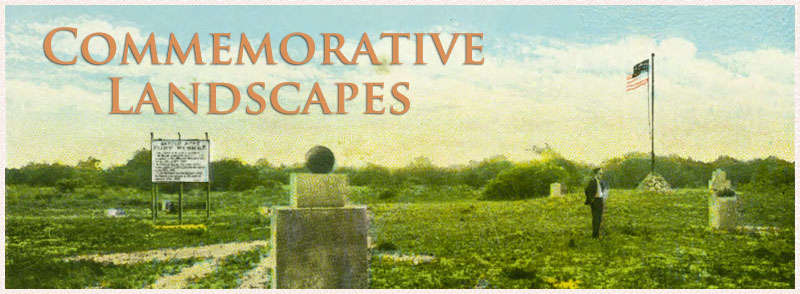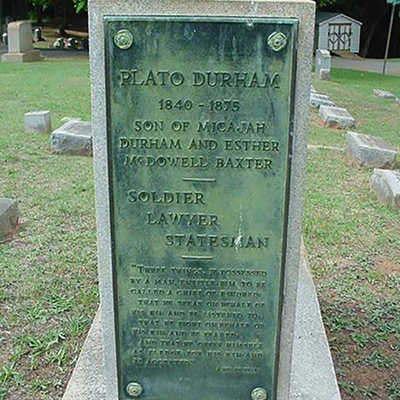
Plato Durham, Shelby
A rectangular granite block on a single granite base designates the Durham family burial plot in Sunset Cemetery. The word Durham is incised into the broad front of the stone. Attached to each narrow side of the stone is a bronze tablet. One side is a memorial to Plato Durham and the other side to family patriarch Micajah Durham.
Images (by Rusty Long):
Far-off view of the memorial |
Footstone |
The Durham family burial plot |
The Durham family burial plot in the Sunset Cemetery
PLATO DURHAM / 1840-1875 / SON OF MICAJAH / DURHAM AND ESTHER / MCDOWELL BAXTER / SOLDIER / LAWYER / STATESMAN / “THREE THINGS IF POSSESSED / BY A MAN, ENTITLE HIM TO BE / CALLED A CHIEF OF KINDRED: / THAT HE SPEAK ON BEHALF OF / KIN AND BE LISTENED TO; / THAT HE FIGHT ON BEHALF OF / OF HIS KIN AND BE FEARED; / AND THAT HE OFFER HIMSELF / AS A PLEDGE FOR HIS KIN AND / BE ACCEPTED.” / A WELSH TRIAD
Sunset Cemetery, City of Shelby
October 1930
35.296100 , -81.546700
View in Geobrowse
"CPT Plato Durham,” Find A Grave, findagrave.com, (accessed August 13, 2023) Link
Drum, Renn. “Bring Remains of Durhams to City Cemetery,” Cleveland Star (Shelby, NC), October 17, 1930
Keeler, O.B. “Lee’s Sculptured Likeness, Greatest of Memorials, Unveiled on Mountainside,” Atlanta Tri-Weekly Journal (Atlanta, GA), January 22, 1924
Newell, Jr., Charles A., 1979. “Baxter, John,” NCpedia.org, (accessed August 14, 2023) Link
Trelease, Allen W., 1986. “Durham, Plato,” NCpedia.org, (accessed August 13, 2023) Link
“Durhams Honor Their Ancestors,” The News And Observer (Raleigh, NC), November 2, 1930
“Micajah “Cage” Durham,” Find A Grave, findagrave.com, (accessed August 13, 2023) Link
“Plato Durham, Hero, Idol of Reconstruction Days,” The Charlotte Observer (Charlotte, NC), March 26, 1933
“Plato Durham,” The Historical Marker Database, HMdb.org, (accessed August 13, 2023) Link
“Portrait of Durham Presented at Finals,” Durham Morning Herald (Durham, NC), June 11, 1946
“Sunset Cemetery,” City of Shelby, (accessed August 13, 2023) Link
Yes
Granite, bronze
Prof. Robert Lee Durham
Prior to the Civil War at age 18 Plato Durham began reading law in Rutherfordton before moving to Knoxville, Tennessee and continuing his law studies under his uncle John Baxter, a former North Carolina state legislator and staunch Unionist. When war broke out, Durham first joined a Confederate company in Knoxville before returning to his home state and enlisted in a Cleveland County company in June 1962. He quickly rose from private to captain and served in the Army of Northern Virginia until the surrender at Appomattox. After the war he attended law school at the University of North Carolina and was admitted to the bar in Shelby in 1866. Having been influenced more by his father, an enthusiastic member of the Secession Convention of 1861 than his Unionist uncle, Plato became wholeheartedly dedicated to the “Lost Cause.” He was elected to the state legislature in 1866 and 1868 and became a leader in the Conservative minority. In 1868 he ran for Congress but his election was overturned on grounds of fraud. In 1870 he again won the Democratic nomination for Congress but withdrew because of his inability to take the test oath for former Confederates. Durham had joined the Ku Klux Klan in late 1868 or early 1869. Although he became alarmed by the amount of violence toward African Americans and white Republicans and tried unsuccessfully to curb the violence he was still arrested by federal authorities in 1871. Although never brought to trial himself he spent the next two years as defense counsel for fellow Klansmen and raising money for their bail and reportedly to bribe jurors. Before his life was cut short at age 35 by pneumonia he was a member of the North Carolina Constitutional Convention of 1875 that dismantled Radical Reconstruction. In 1946 Durham’s son, Robert Lee Durham, donated an oil portrait of Plato to the Southern Historical Collection during the University of North Carolina’s commencement program. Also of note is that another son, Plato Durham, Jr. was a board member for the Stone Mountain Memorial Association, continuing his father’s work in constructing the myth of the “Lost Cause.” He was the featured speaker during the unveiling of Robert E. Lee’s head, the first portion of the monument completed, in January 1924.
The memorial marker and grave for Plato Durham are located in Sunset Cemetery, 412 W. Sumter Street, Shelby, NC. The plaque for his father Micajah Durham is in the other side of the memorial marker. They are located on the east side of the “old section” of the cemetery in the Durham family plot.
The memorial is surrounded by graveyards.
Yes
 Know anything else about this monument that isn't mentioned here? If you have additional information on
this or any other monument in our collection fill out the form at the Contact Us link in the footer. Thank you.
Know anything else about this monument that isn't mentioned here? If you have additional information on
this or any other monument in our collection fill out the form at the Contact Us link in the footer. Thank you.

